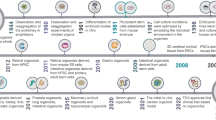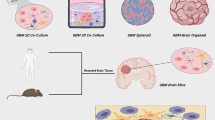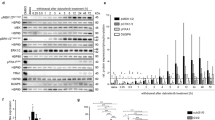Abstract
Medulloblastoma is a malignant pediatric brain neoplasm with an unusual predilection for metastasis to the skeleton. The objective of this study was to generate and characterize murine models of medulloblastoma extraneural growth in bone as ‘discovery tools’ for the identification of unrecognized signal transduction pathways and factors driving metastatic bone disease. To this end, the human Daoy and D283 medulloblastoma cell lines were inoculated into the intratibial medullary space of athymic nude mice. Daoy injected mice developed a primarily osteolytic radiographic and histological phenotype. In contrast, both areas of osteolytic and osteosclerotic activity were evident in D283 inoculated bones. D283 and Daoy cell conditioned media increased in vitro osteoblast differentiation and is consistent with the enhanced bone turnover characteristic of bone metastases. Daoy cells also significantly increased bone marrow osteoclast formation, consistent with the robust in vivo osteolytic phenotype. A survey of secreted factors implicated in bone metastasis and expressed by D283 and Daoy was performed. High expression of the bone-homing factor, CXCR4, was observed in both Daoy and D283 tissues. Consistent with the skeletal phenotypes, Daoy cells, while secreting the osteoblastic factor ET-1, abundantly produced the osteolytic factors RANKL, PTHrP and TNFα. D283 cells produced high levels of both RANKL and ET-1. These newly described animal models of medulloblastoma bone metastasis are expected to serve as platforms to aid in the elucidation of novel bone metastasis signaling cascades and to test therapeutics that target both medulloblastoma metastasis and the primary tumor.




Similar content being viewed by others
Abbreviations
- ATCC:
-
American Type Culture Collection
- CXCR4:
-
C-X-C chemokine receptor 4
- D283:
-
D283 Med
- DAB:
-
Diaminobenzidine
- DKK1:
-
Dickkopf homologue 1
- ET-1:
-
Endothelin-1
- HRP:
-
Horseradish peroxidase
- PTHrP:
-
Parathyroid hormone-related protein
- RANKL:
-
Receptor activator of nuclear factor kappa-β ligand
- TACE:
-
TNF-a-converting enzyme
- TGFβ:
-
Transforming growth factor beta
- TNFα:
-
Tumor necrosis factor alpha
- TRAP:
-
Tartrate-resistant acid phosphatase
- WHO:
-
World Health Organization
References
CBTRUS (2012) CBTRUS statistical report: primary brain and central nervous system tumors diagnosed in the United States in 2004–2008. Central Brain Tumor Registry of the United States, Hindsdale
Brandes AA, Franceschi E, Tosoni A, Reni M, Gatta G, Vecht C, Kortmann RD (2009) Adult neuroectodermal tumors of posterior fossa (medulloblastoma) and of supratentorial sites (stPNET). Crit Rev Oncol Hematol 71(2):165–179. doi:10.1016/j.critrevonc.2009.02.002
Jozwiak J, Grajkowska W, Wlodarski P (2007) Pathogenesis of medulloblastoma and current treatment outlook. Med Res Rev 27(6):869–890. doi:10.1002/med.20088
Packer RJ, Cogen P, Vezina G, Rorke LB (1999) Medulloblastoma: clinical and biologic aspects. Neuro Oncol 1(3):232–250
Mazloom A, Zangeneh AH, Paulino AC (2010) Prognostic factors after extraneural metastasis of medulloblastoma. Int J Radiat Oncol Biol Phys 78(1):72–78. doi:10.1016/j.ijrobp.2009.07.1729
Coleman RE, Rubens RD (1987) The clinical course of bone metastases from breast cancer. Br J Cancer 55(1):61–66
Weigelt B, Peterse JL, van ‘t Veer LJ (2005) Breast cancer metastasis: markers and models. Nat Rev Cancer 5(8):591–602. doi:10.1038/nrc1670
Bubendorf L, Schopfer A, Wagner U, Sauter G, Moch H, Willi N, Gasser TC, Mihatsch MJ (2000) Metastatic patterns of prostate cancer: an autopsy study of 1,589 patients. Hum Pathol 31(5):578–583
Langley RR, Fidler IJ (2011) The seed and soil hypothesis revisited: the role of tumor-stroma interactions in metastasis to different organs. Int J Cancer 128(11):2527–2535. doi:10.1002/ijc.26031
Paget S (1989) The distribution of secondary growths in cancer of the breast. 1889. Cancer Metastasis Rev 8(2):98–101
Chen YC, Sosnoski DM, Mastro AM (2010) Breast cancer metastasis to the bone: mechanisms of bone loss. Breast Cancer Res 12(6):215. doi:10.1186/bcr2781
Guise TA, Yin JJ, Taylor SD, Kumagai Y, Dallas M, Boyce BF, Yoneda T, Mundy GR (1996) Evidence for a causal role of parathyroid hormone-related protein in the pathogenesis of human breast cancer-mediated osteolysis. J Clin Invest 98(7):1544–1549. doi:10.1172/JCI118947
Yin JJ, Selander K, Chirgwin JM, Dallas M, Grubbs BG, Wieser R, Massague J, Mundy GR, Guise TA (1999) TGF-beta signaling blockade inhibits PTHrP secretion by breast cancer cells and bone metastases development. J Clin Invest 103(2):197–206. doi:10.1172/JCI3523
Weilbaecher KN, Guise TA, McCauley LK (2011) Cancer to bone: a fatal attraction. Nat Rev Cancer 11(6):411–425. doi:10.1038/nrc3055
Yin JJ, Mohammad KS, Kakonen SM, Harris S, Wu-Wong JR, Wessale JL, Padley RJ, Garrett IR, Chirgwin JM, Guise TA (2003) A causal role for endothelin-1 in the pathogenesis of osteoblastic bone metastases. Proc Natl Acad Sci USA 100(19):10954–10959. doi:10.1073/pnas.1830978100
Clines GA, Mohammad KS, Bao Y, Stephens OW, Suva LJ, Shaughnessy JD Jr, Fox JW, Chirgwin JM, Guise TA (2007) Dickkopf homolog 1 mediates endothelin-1-stimulated new bone formation. Mol Endocrinol 21(2):486–498. doi:10.1210/me.2006-0346
Drake JM, Danke JR, Henry MD (2010) Bone-specific growth inhibition of prostate cancer metastasis by atrasentan. Cancer Biol Ther 9(8):607–614
Ibrahim T, Flamini E, Mercatali L, Sacanna E, Serra P, Amadori D (2010) Pathogenesis of osteoblastic bone metastases from prostate cancer. Cancer 116(6):1406–1418. doi:10.1002/cncr.24896
Paulino AC (2003) Long-term survival in a child with extraneural metastasis from medulloblastoma treated with chemo-radiotherapy. Med Pediatr Oncol 40(6):396–397. doi:10.1002/mpo.10198
Booher KR Jr, Schmidtknecht TM (1977) Cerebellar medulloblastoma with skeletal metastases: case report and review of the literature. J Bone Joint Surg Am 59(5):684–686
Zhau HE, Odero-Marah V, Lue HW, Nomura T, Wang R, Chu G, Liu ZR, Zhou BP, Huang WC, Chung LW (2008) Epithelial to mesenchymal transition (EMT) in human prostate cancer: lessons learned from ARCaP model. Clin Exp Metastasis 25(6):601–610. doi:10.1007/s10585-008-9183-1
van’t Hof RJ (2003) Osteoclast formation in the mouse coculture assay. In: Helfirch MH, Ralston SH (eds) Methods in molecular medicine: bone research protocols. Humana Press, Totowa, pp 145–152
Takahashi N, Akatsu T, Udagawa N, Sasaki T, Yamaguchi A, Moseley JM, Martin TJ, Suda T (1988) Osteoblastic cells are involved in osteoclast formation. Endocrinology 123(5):2600–2602
Raffel C (2004) Medulloblastoma: molecular genetics and animal models. Neoplasia 6(4):310–322. doi:10.1593/neo.03454
Spiller SE, Ditzler SH, Pullar BJ, Olson JM (2008) Response of preclinical medulloblastoma models to combination therapy with 13-cis retinoic acid and suberoylanilide hydroxamic acid (SAHA). J Neurooncol 87(2):133–141. doi:10.1007/s11060-007-9505-1
Peyrl A, Krapfenbauer K, Slavc I, Yang JW, Strobel T, Lubec G (2003) Protein profiles of medulloblastoma cell lines DAOY and D283: identification of tumor-related proteins and principles. Proteomics 3(9):1781–1800. doi:10.1002/pmic.200300460
Kingsley LA, Fournier PG, Chirgwin JM, Guise TA (2007) Molecular biology of bone metastasis. Mol Cancer Ther 6(10):2609–2617. doi:10.1158/1535-7163.MCT-07-0234
Clezardin P, Teti A (2007) Bone metastasis: pathogenesis and therapeutic implications. Clin Exp Metastasis 24(8):599–608. doi:10.1007/s10585-007-9112-8
Suva LJ, Washam C, Nicholas RW, Griffin RJ (2011) Bone metastasis: mechanisms and therapeutic opportunities. Nat Rev Endocrinol 7(4):208–218. doi:10.1038/nrendo.2010.227
Sterling JA, Edwards JR, Martin TJ, Mundy GR (2011) Advances in the biology of bone metastasis: how the skeleton affects tumor behavior. Bone 48(1):6–15. doi:10.1016/j.bone.2010.07.015
Bussard KM, Gay CV, Mastro AM (2008) The bone microenvironment in metastasis; what is special about bone? Cancer Metastasis Rev 27(1):41–55. doi:10.1007/s10555-007-9109-4
Leibbrandt A, Penninger JM (2008) RANK/RANKL: regulators of immune responses and bone physiology. Ann N Y Acad Sci 1143:123–150. doi:10.1196/annals.1443.016
Nicolin V, Bortul R, Bareggi R, Baldini G, Martinelli B, Narducci P (2008) Breast adenocarcinoma MCF-7 cell line induces spontaneous osteoclastogenesis via a RANK-ligand-dependent pathway. Acta Histochem 110(5):388–396. doi:10.1016/j.acthis.2007.12.002
Datta NS, Abou-Samra AB (2009) PTH and PTHrP signaling in osteoblasts. Cell Signal 21(8):1245–1254. doi:10.1016/j.cellsig.2009.02.012
Schett G (2011) Effects of inflammatory and anti-inflammatory cytokines on the bone. Eur J Clin Invest 41(12):1361–1366. doi:10.1111/j.1365-2362.2011.02545.x
Lau J, Schmidt C, Markant SL, Taylor MD, Wechsler-Reya RJ, Weiss WA (2012) Matching mice to malignancy: molecular subgroups and models of medulloblastoma. Child’s Nerv Syst 28(4):521–532. doi:10.1007/s00381-012-1704-1
Markant SL, Wechsler-Reya RJ (2012) Review: personalized mice: modelling the molecular heterogeneity of medulloblastoma. Neuropathol Appl Neurobiol 38(3):228–240. doi:10.1111/j.1365-2990.2011.01235.x
Roussel MF, Hatten ME (2011) Cerebellum development and medulloblastoma. Curr Top Dev Biol 94:235–282. doi:10.1016/B978-0-12-380916-2.00008-5
Dunn LK, Mohammad KS, Fournier PG, McKenna CR, Davis HW, Niewolna M, Peng XH, Chirgwin JM, Guise TA (2009) Hypoxia and TGF-beta drive breast cancer bone metastases through parallel signaling pathways in tumor cells and the bone microenvironment. PLoS One 4(9):e6896. doi:10.1371/journal.pone.0006896
Yang JC, Bai L, Yap S, Gao AC, Kung HJ, Evans CP (2010) Effect of the specific Src family kinase inhibitor saracatinib on osteolytic lesions using the PC-3 bone model. Mol Cancer Ther 9(6):1629–1637. doi:10.1158/1535-7163.MCT-09-1058
Lum L, Wong BR, Josien R, Becherer JD, Erdjument-Bromage H, Schlondorff J, Tempst P, Choi Y, Blobel CP (1999) Evidence for a role of a tumor necrosis factor-alpha (TNF-alpha)-converting enzyme-like protease in shedding of TRANCE, a TNF family member involved in osteoclastogenesis and dendritic cell survival. J Biol Chem 274(19):13613–13618
Boissy P, Lenhard TR, Kirkegaard T, Peschon JJ, Black RA, Delaisse JM, del Carmen Ovejero M (2003) An assessment of ADAMs in bone cells: absence of TACE activity prevents osteoclast recruitment and the formation of the marrow cavity in developing long bones. FEBS Lett 553(3):257–261
Romas E, Gillespie MT, Martin TJ (2002) Involvement of receptor activator of NFkappaB ligand and tumor necrosis factor-alpha in bone destruction in rheumatoid arthritis. Bone 30(2):340–346
Gessi M, Monego G, Calviello G, Lanza P, Giangaspero F, Silvestrini A, Lauriola L, Ranelletti FO (2007) Human parathyroid hormone-related protein and human parathyroid hormone receptor type 1 are expressed in human medulloblastomas and regulate cell proliferation and apoptosis in medulloblastoma-derived cell lines. Acta Neuropathol 114(2):135–145. doi:10.1007/s00401-007-0212-y
Schuller U, Koch A, Hartmann W, Garre ML, Goodyer CG, Cama A, Sorensen N, Wiestler OD, Pietsch T (2005) Subtype-specific expression and genetic alterations of the chemokine receptor gene CXCR4 in medulloblastomas. Int J Cancer 117(1):82–89. doi:10.1002/ijc.21116
Caraci F, Busceti C, Biagioni F, Aronica E, Mastroiacovo F, Cappuccio I, Battaglia G, Bruno V, Caricasole A, Copani A, Nicoletti F (2008) The Wnt antagonist, Dickkopf-1, as a target for the treatment of neurodegenerative disorders. Neurochem Res 33(12):2401–2406. doi:10.1007/s11064-008-9710-0
Vibhakar R, Foltz G, Yoon JG, Field L, Lee H, Ryu GY, Pierson J, Davidson B, Madan A (2007) Dickkopf-1 is an epigenetically silenced candidate tumor suppressor gene in medulloblastoma. Neuro Oncol 9(2):135–144. doi:10.1215/15228517-2006-038
Acknowledgments
We would like to acknowledge the University of Alabama at Birmingham Center for Metabolic Bone Disease (CMBD) Histomorphometry and Animal Phenotyping Cores for their excellent services and for providing expertise on the described experiments. We would also like to extend our gratitude to Dr. Burt Nabors and Katrina Clines for their assistance on this project. This study was supported by NIH K08 CA118428 (G.C.) and the University of Alabama at Birmingham Center for Metabolic Bone Disease (CMBD) NIH T32AR047512 and P30AR046031.
Conflict of interest
The authors declare that they have no conflict of interest.
Author information
Authors and Affiliations
Corresponding author
Rights and permissions
About this article
Cite this article
Grunda, J.M., Wang, D. & Clines, G.A. Development and characterization of murine models of medulloblastoma extraneural growth in bone. Clin Exp Metastasis 30, 769–779 (2013). https://doi.org/10.1007/s10585-013-9577-6
Received:
Accepted:
Published:
Issue Date:
DOI: https://doi.org/10.1007/s10585-013-9577-6




